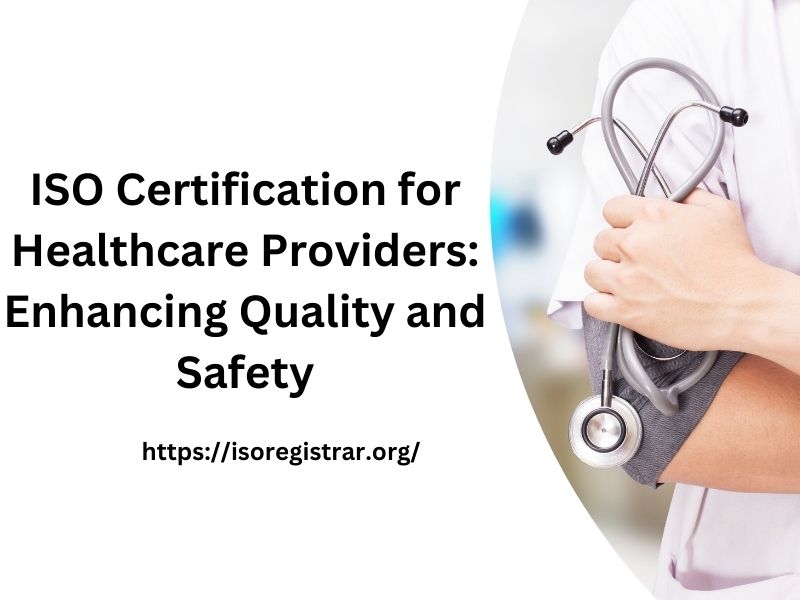Notifications

In the ever-evolving healthcare landscape, quality and safety are paramount ISO certification offers healthcare providers a structured approach to meet high standards and improve patient outcomes. This article explores how ISO certification enhances quality and safety in healthcare settings, the benefits of various ISO standards, and practical steps for implementation.
ISO certification provides a framework for healthcare organizations to systematically manage quality and safety. As healthcare providers face increasing pressure to improve patient care, adhere to regulatory requirements, and operate efficiently, ISO standards offer valuable guidance and tools.
1. Enhancing Quality Management:
ISO 9001, the most widely recognized quality management standard, is increasingly adopted by healthcare providers. This standard focuses on meeting customer needs and enhancing satisfaction. For healthcare organizations, this translates to improved patient care, streamlined processes, and enhanced service delivery.
ISO 9001 helps healthcare providers establish robust quality management systems (QMS) that focus on continuous improvement. By adhering to ISO 9001, healthcare organizations can standardize procedures, reduce variability in patient care, and ensure that quality metrics are consistently met.
2. Ensuring Patient Safety:
Patient safety is a critical concern in healthcare, and ISO certification plays a significant role in addressing this issue. ISO 13485, specifically designed for medical device quality management, helps organizations ensure that medical devices meet regulatory requirements and are safe for use.
ISO 13485 covers all aspects of the medical device lifecycle, from design and development to manufacturing and post-market surveillance. By complying with ISO 13485, healthcare providers can minimize the risk of device-related incidents, ensure regulatory compliance, and enhance patient safety.
3. Achieving Effective Environmental Management:
ISO 14001, the environmental management standard, is relevant for healthcare providers committed to sustainable practices. Healthcare facilities generate significant waste and consume substantial resources. ISO 14001 helps organizations manage their environmental impact by promoting sustainable practices and compliance with environmental regulations.
Implementing ISO 14001 can lead to reduced waste, lower energy consumption, and improved waste management. This not only benefits the environment but also contributes to operational efficiency and cost savings.
4. Maintaining Information Security:
In the digital age, safeguarding patient information is crucial. ISO 27001, the standard for information security management, helps healthcare providers protect sensitive data from breaches and unauthorized access. This standard establishes a framework for managing information security risks and ensuring the confidentiality, integrity, and availability of patient data.
ISO 27001 helps healthcare organizations implement robust security controls, conduct risk assessments, and maintain secure information systems. By achieving ISO 27001 certification, healthcare providers can build trust with patients, comply with data protection regulations, and reduce the risk of data breaches.
5. Fostering Business Continuity:
ISO 22301, the standard for business continuity management, is essential for healthcare providers to ensure that critical services remain operational during disruptions. Whether facing natural disasters, pandemics, or other emergencies, ISO 22301 helps organizations develop and implement effective business continuity plans.
ISO 22301 provides guidelines for risk assessment, emergency response, and recovery planning. By adopting this standard, healthcare organizations can enhance their resilience, minimize disruptions, and maintain the continuity of patient care during crises.
Achieving ISO certification involves several key steps that healthcare providers should follow:
1. Assess Current Practices:
Begin by conducting a thorough assessment of current practices and identifying areas for improvement. This includes reviewing existing quality management systems, patient safety protocols, and environmental and information security practices.
2. Develop a Quality Management System (QMS):
Create a comprehensive QMS that aligns with the relevant ISO standards. This involves defining policies, procedures, and responsibilities, and establishing a framework for continuous improvement. Engage key stakeholders, including healthcare professionals and administrative staff, in developing and implementing the QMS.
3. Implement the Standards:
Once the QMS is developed, implement the necessary changes and processes to comply with the ISO standards. This includes training staff, updating documentation, and establishing monitoring and measurement systems.
4. Conduct Internal Audits:
Regular internal audits are essential for evaluating the effectiveness of the QMS and identifying areas for improvement. Conduct audits to assess compliance with ISO standards and address any non-conformities or gaps.
5. Seek Certification from an Accredited Body:
Select an accredited certification body to conduct an external audit and verify compliance with the ISO standards. The certification body will assess your organization's adherence to the standards and provide recommendations for improvement if needed.
6. Maintain and Improve:
ISO certification is an ongoing process that requires continuous monitoring and improvement. Regularly review and update your QMS, conduct internal audits, and address any issues to maintain certification and drive continuous improvement.
ISO certification offers numerous benefits for healthcare providers:
1. Improved Patient Care:
By implementing ISO standards, healthcare organizations can enhance the quality of care, reduce errors, and improve patient outcomes.
2. Enhanced Operational Efficiency:
ISO certification helps streamline processes, reduce waste, and optimize resource utilization, leading to greater operational efficiency.
3. Regulatory Compliance:
Achieving ISO certification demonstrates compliance with industry regulations and standards, reducing the risk of regulatory issues and penalties.
4. Increased Patient Trust:
ISO certification builds trust with patients by demonstrating a commitment to high-quality care and patient safety.
5. Competitive Advantage:
ISO certification differentiates healthcare providers in a competitive market, attracting patients and enhancing the organization's reputation.
6. Risk Management:
ISO standards help healthcare organizations identify and manage risks, improving resilience and ensuring the continuity of critical services.
Note: apply on ISO 9001-2015 for new users through the portal
ISO certification offers healthcare providers a structured approach to enhancing quality, safety, and operational efficiency. By adopting ISO standards, healthcare organizations can improve patient care, ensure regulatory compliance, and build trust with patients. Achieving and maintaining ISO certification requires a commitment to continuous improvement, but the benefits are substantial, making it a valuable investment for any healthcare provider dedicated to excellence in patient care.